Menus
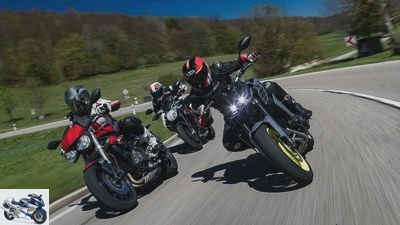
r-photography.info
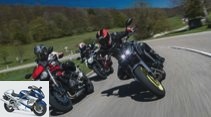
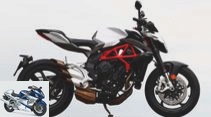
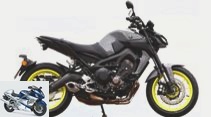
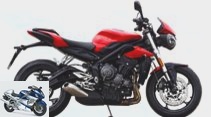
30th photos
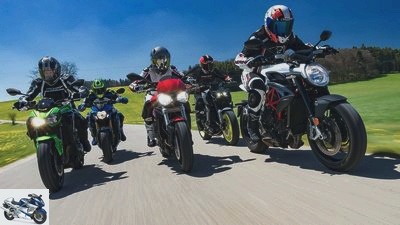
r-photography.info
1/30
With the Z 900 Kawasaki pushes the middle class close to the full liter. Does this mean that the four-in-line strikes back after Yamaha three-cylinder dominance? Are the Suzuki GSX-S 750 and Triumph Street Triple S 765 cubic enough to counter? Where is the noble Brutale 800? Redefining a class.

r-photography.info
2/30
The three-cylinder.
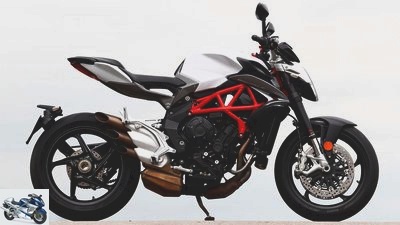
r-photography.info
3/30
MV Agusta Brutale 800
short, high, airy, hard: the geometry and seating position of the MV are as brutal as the name.
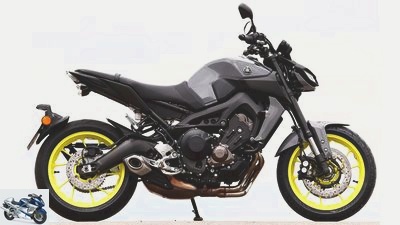
r-photography.info
4/30
Yamaha MT-09
Upright sitting position: the high front and low notches characterize the MT-09.
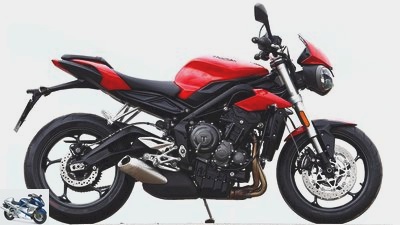
r-photography.info
5/30
Triumph Street Triple S
Flatter, more elongated: high padding, lower front. Fine banana swing arm, typical headlight.
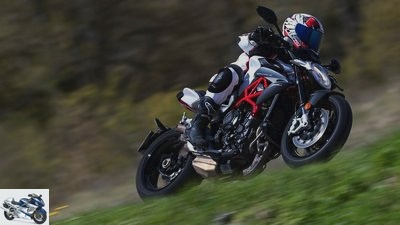
r-photography.info
6/30
MV Agusta Brutale 800 – Sex on Wheels! But accordingly demanding. Beautiful, rough and exhausting.
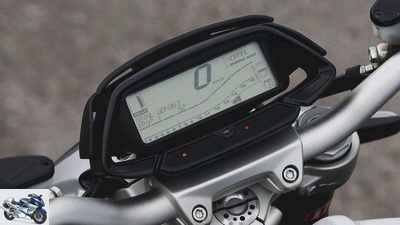
r-photography.info
7/30
Very compact information center with poor readability and barely noticeable lights.
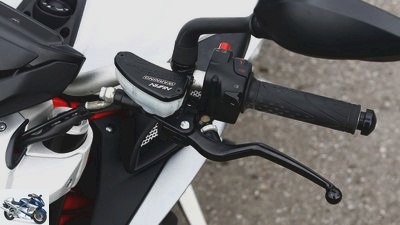
r-photography.info
8/30
The only hydraulic clutch in the field, nevertheless very high manual force; Adjustable lever
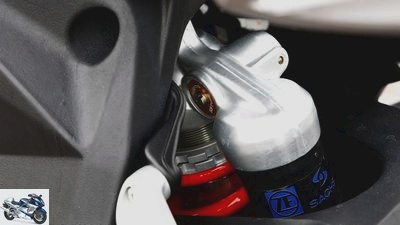
r-photography.info
9/30
The damping setting of the Sachs shock absorber is inaccessible behind the frame.
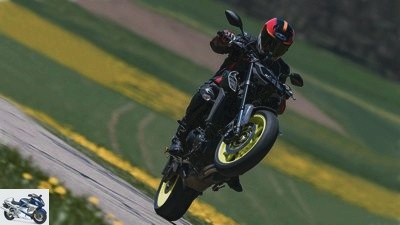
r-photography.info
10/30
Yamaha MT-09 – Motor-Rad: Furthermore, the MT-09 first impresses with its amazing unit.
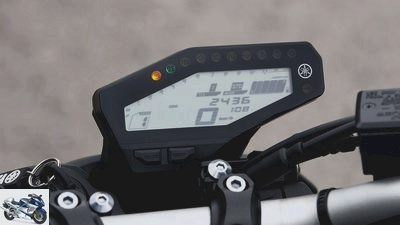
r-photography.info
11/30
The MT cockpit is also small, but easy to read. Quickshift light in green.
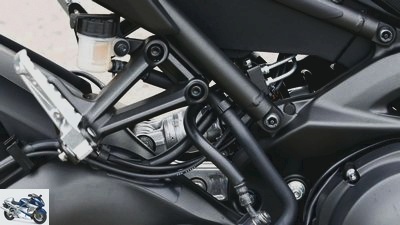
r-photography.info
12/30
The tangle of hoses on the ABS control unit is not very elegant. Passenger pegs installed too high.
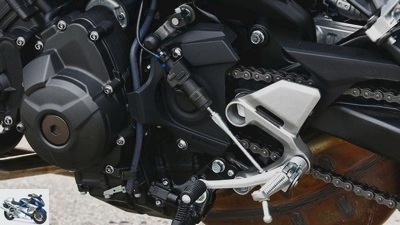
r-photography.info
13/30
The Quickshifter is new from model year 2017, its function is partly good, partly bad.
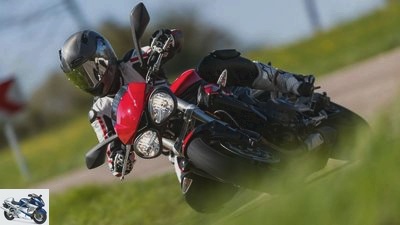
r-photography.info
14/30
Triumph Street Triple S – Timeless British elegance in a class that usually lags behind fashion.
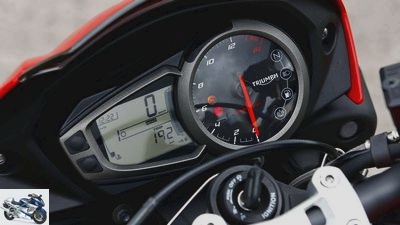
r-photography.info
15/30
The basic version of the new Street Triple saves the TFT display. Not bad.
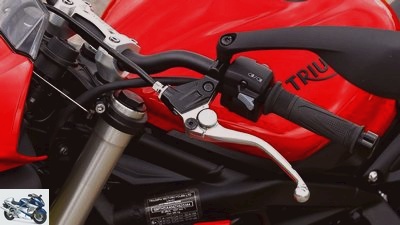
r-photography.info
16/30
Adjustable lever of the fairly smooth clutch, good build quality.
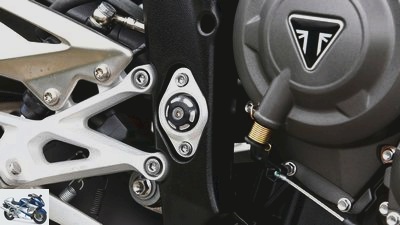
r-photography.info
17/30
Attention to detail is also evident in details such as the swing arm mounting.
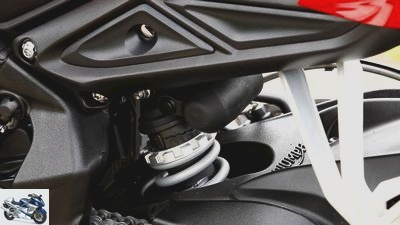
r-photography.info
18/30
The spring of our test motorcycle was not pretensioned, so increase it if necessary.
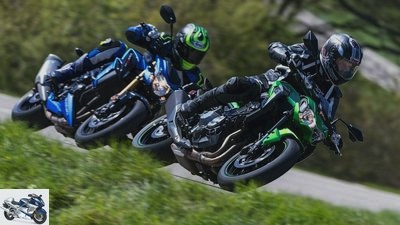
r-photography.info
19/30
The four-cylinder.
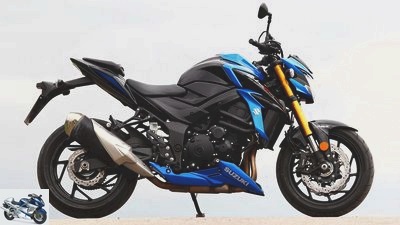
r-photography.info
20/30
Suzuki GSX-S 750
The successor to the GSR 750 takes up the design of the larger GSX-S 1000, looks beefy and stocky.
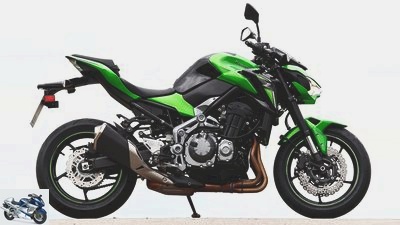
r-photography.info
21/30
Kawasaki Z 900
Unmistakably Z. The standard bench is quite low, an accessory alleviates this.
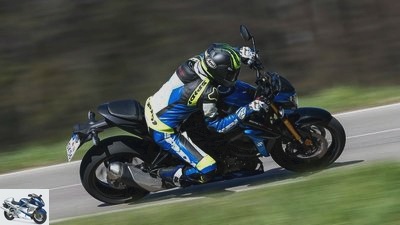
r-photography.info
22/30
Suzuki GSX-S 750 – everyday life in focus: cost and comfort are your strengths.
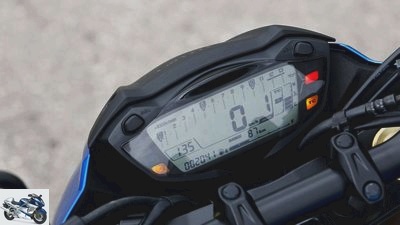
r-photography.info
23/30
The Suzuki speedometer comes from the larger GSX-S 1000 and is one of the best in the field.
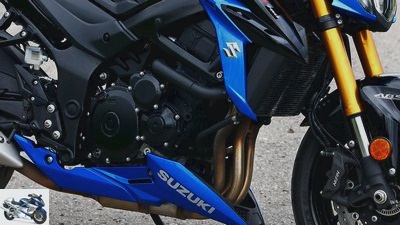
r-photography.info
24/30
Old-Style: The former GSX-R-750 unit is generously encompassed by the frame.

r-photography.info
25/30
Simple box swingarm like Kawa, but the tensioner is nicely made.
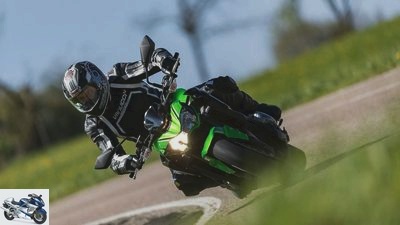
r-photography.info
26/30
Daddy’s home – with the Z 900 Kawasaki puts the four-cylinder back at the top!
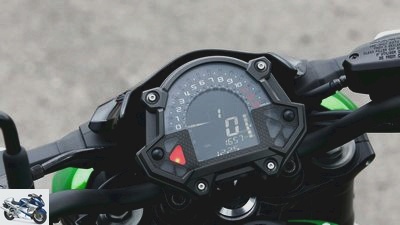
r-photography.info
27/30
The readability and information content of the LCD speedometer are okay, but it looks cheap.
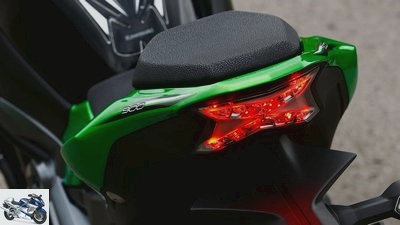
r-photography.info
28/30
Zett through and through: Everywhere on the 900 there are small Z-reminiscences.
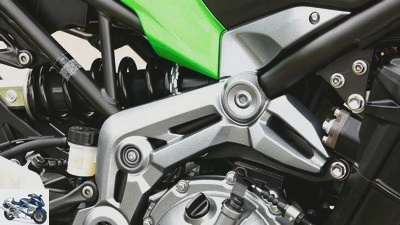
r-photography.info
29/30
The tubular space frame has to hide behind a questionable plastic panel.
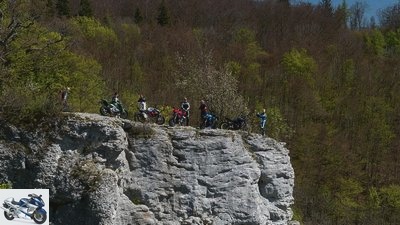
r-photography.info
30/30
Mid-range nakeds in a comparison test.
Middle class naked bikes in comparison test
Five current bikes, one winner
With the Kawasaki Z 900, Kawasaki is pushing the middle class close to full liters. After the dominance of the Yamaha MT-09, will the four-in-line strike back? Are the Suzuki GSX-S 750 and Triumph Street Triple S 765 cubic enough to counter? Where is the noble MV Agusta Brutale 800? Redefining a class.
HWould anyone seriously bet on it ten years ago? When the Street Triple, at that time still with a 675 three-cylinder, was presented for the first time in 2007, hardly anyone would have believed that a decade later the three-cylinder would replace the in-line four as the most widely used engine concept in the middle class.
Buy complete article
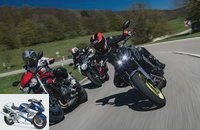
Middle class naked bikes in comparison test
Five current bikes, one winner
Yamaha MT-09 the first modern Japanese treble. And that shifted the standard in the middle class in terms of displacement and driving performance up again. In the meantime the MV drove through the country with a proper 800 cm³. The former trendsetter from Hinckley began to lose touch in terms of performance. But now Triumph is sending the Street Triple 765 into the race to restore the old hierarchy.
So let us first consider the group of tridents, where there is no trace of monotonous monotony. On the contrary, diversity is blooming here.
The MV Agusta is a treat for the eye, a feast for aesthetes. Albeit a very expensive one at 13,490 euros. Adorable lines, three exhaust pipes, single swing arm, tubular space frame. In addition, fine details such as hinged clamps for handlebars and mirrors. The seating position: Aggressive, felt directly above the front wheel, the pilot is placed on the sparse seat cushion. Grab a handlebar as wide and straight as a foil, ready to attack the next bend. The contrast program comes from Yamaha. The design is angular and independent, technocratic, the dark side of Japan. The pilot sits upright, relaxed. Open knee angle thanks to deep notches. The seating position seems almost a bit passive, with the proximity to the handlebars adding a hint of a supermoto feeling.
Triumph is somewhere in between. Avoids shrill shapes and colors, her clear, classic-sporty line tells of British elegant understatement. Only the double headlights – a legacy of their ancestors – add a touch of eccentricity to the design. The seating position: Quite sporty for romping around the house route with knees bent accordingly, still loose enough to spend a day in the saddle. Successful for sports fans.
The MV doesn’t want to know anything about relaxed. Highly motivated, she attacks the small winding country roads of the Swabian Alb. None of the three turns as greedily as the Italian. However, the joy only lasts on well-groomed asphalt and in long radii. Then the only fully adjustable spring elements in the test field provide full stability. When things get down to business, late on the brakes, jagged lean changes, even on undulating asphalt, then the sovereignty is over. Every bump, every impulse directs movement into the chassis, which reacts sensitively. The precision disappears, nervousness mixes with the handiness. The engine does the first opening of the throttle valve finely and accurately, but then hangs downright snappy and directly on the gas. Every smallest turn is answered immediately with propulsion. The triplet won’t hold still. The automatic gearshift lined up seamlessly gear after gear, at least at high speeds. In the case of low gear changes in the bony gearbox, the grip on the stiff clutch is the better choice.
No question about it, when it comes to a sporty ride, concentration is required on the MV It actually has everything it needs for fumigating. Stable chassis, richly damping, responsive spring elements, the first-class Pirelli Rosso III. The engine goes smoothly, and thanks to the short gear ratio, it gets down to business. Sounds smoky, archaic, with pithy mechanical nuances. It pulls through great, even if its fire does not burn quite as hot from 9000 rpm. And the MV has brakes on top of that, but also a noticeable stoppy tendency. The eye is also offered a lot. Careful workmanship, beautiful surfaces, an extensive cockpit that houses what is probably the smallest clock in the motorcycle world and, unfortunately, also scintillating control lights. And its operation is still fiddly. It is also unfortunate that the shock absorber’s compression adjuster is hidden from view by the frame. The search for more comfort from the hindquarters remains unsuccessful on bumpy roads. Sharp edges penetrate the driver bone dry. The MV demands, is stimulating like a double espresso. Cruise comfortably? Also works if it has to be.
If you are looking for more comfort, you will find it with the Yamaha. Not only because of the upright sitting position and the cuddly seat cushion. The spring elements process asphalt wrinkles much more carefully. The fully adjustable fork is particularly responsive, but the shock absorber also assiduously filters bumps out of the road. The other side of the coin: The set-up is too soft for dedicated cornering. Sloping bumps in particular push the hindquarters to their limits. Courageously driven by rapid following curves, the MT-09 reacts to waves with indignant agitation. However, you never get the impression that the Yamaha could go off course as a result. In spite of the noticeable moment of erection when reaching for the brakes that grip forcefully and spontaneously. The Yamaha chassis is therefore not completely neutral. On the other hand, it is pleasantly handy, which makes rhythmic curve swing a relaxed affair. And then there is this bearish 850 three-cylinder that got an anti-hopping clutch for 2017.
Meanwhile, his load changes have improved significantly. Not great, but acceptable. And at least the gentle B-mode offers smooth response. A good choice, especially on narrow routes or in city traffic. It is wonderful how the powerful three-of-a-kind pushes out of the corners from low speeds, making the intermediate sprint from curve to curve an entertaining pleasure thanks to ample torque. The crossplane engine pushes hard, marches powerfully through the middle area and tirelessly pulls forward at up to 10,000 rpm. The engine clearly shapes the appearance of the MT and is of enormous entertainment value. With 4.3 liters per 100 kilometers of consumption, it doesn’t even have to be bought with insubordinate fuel consumption. The MV takes a slightly stronger sip, but with 4.9 liters it doesn’t go too far.
All in all, however, the MT proves to be a more eager point collector and thus keeps the MV at a distance. But you can do that with Triumph too?
After the exciting appearance of the Street Triple in the top RS version, the cheaper, more simply equipped basic version “S” now has to prove itself.
And that shows in the crowd of curves that she did not come to queue at the back. Tighter than the Yamaha, more comfortable than the MV, the simple, average-appealing spring elements ensure good contact with the road. Even in faster corners. Even if the Streety does not quite come close to the handiness of the other two. On the other hand, it seems most concentrated when it comes to choosing the line, can hardly be deterred by road warpage and precisely follows the chosen line. However, two things are necessary for this: On the one hand, the aged Pirelli Diablo Rosso Corsa, which unwillingly turn in the cold state, must have warmed up properly. On the other hand, the only adjustment option on the chassis should be used and the spring strut, which is completely relaxed as standard, should be pretensioned a few steps. This lifts the rear a bit and harmonizes better with the somewhat tight rebound damping. Then the Triumph witscht crisp through the curve sequences. Your seating position is made for robbery. And not just that. The engine accelerates smoothly. Doesn’t pull the chain as vigorously as the larger-displacement competition. To do this, it ignites the afterburner from 8000 rpm. And thanks to the lightest weight and short gear ratio – at a striking 240 km / h it runs into the limiter – it keeps up. In an emergency, you have to shift down a gear at the exit of a curve, but then the hut burns. And the small, frame-mounted cockpit fairing actually provides significant wind protection.
Incidentally, the Triumph does not offer a gearshift like the other two, but it is also not bad in view of the slipperiest gear changes. The only thing that disturbs the fun of cornering is the very defensive set-up of the non-adjustable traction control. In a great incline, it already intervenes overcautiously when the throttle is opened for the first time and releases the power gently, but only cautiously. Incidentally, you don’t have to pay an express surcharge at the pump for robbing. With 4.7 liters, the Triumph-Drilling is still moderate. It also runs extremely smoothly. If it purrs at the bottom, there is only slight vibration in the upper layers. A fine drive.
On the other hand, there are basically quite powerful brakes on the side, which grip strongly despite simple floating calipers. However, there is criticism for the long idle travel of the brake lever on the simple brake pump, which is then followed by spontaneous grabbing. What deductions in terms of dosability. The limited adjustment range of the rearview mirror is also not the last word.
Otherwise, however, the Triumph pleases with its clean, routine workmanship. It doesn’t offer a TFT display like its sister RS, but the well-known cockpit with a large, analog tachometer is certainly not the worst choice in terms of readability.
The bottom line is that the new Streety turns out to be the most powerful package among the three-cylinder models. Good prerequisites for overall victory, as the four-cylinder engines seem to fall a little behind in this class because of their supposed lack of torque.
In view of the unbroken charisma that emanates from Triumph’s new Street Triple, in view of the recognized strong MT-09 and the unconditionally classy appearance of the MV, Suzuki’s new entry into the segment, the GSX-S 750, seems a bit lackluster. Maybe it’s because, compared to its predecessor, the chronically underestimated GSR 750, not too much has apparently changed? The frame and four-cylinder engine are basically unchanged, just treat themselves to a new look that is based on its big sister, along with its cockpit, a handful of additional horses, traction control and new initial tires. Meaningful detail optimizations, but nothing earth-shattering. At 214 kilos just under the heaviest, with 749 cubic meters, 78 Nm, 108 hp just under the weakest, no fancy features – anyone who compares the key data before the journey must suspect something bad for the GSX-S. But he would be completely wrong. Because like its predecessor, the blue one is an inconspicuously good all-rounder in the best sense, a very balanced overall package without any real weaknesses.
Less front wheel-oriented than the Streety, but more aggressive than the MT-09, the brawny looking GSX-S positions the pilot, the ergonomic triangle of medium-high notches, not too low seat and rather flat, rather narrow handlebars pretty much marks the class standard. Just fits. The tank is quite wide, but the nicely padded seat cushion and decent knee closure make up for it. When driving, there is no need to think about the four-cylinder pounds – the GSX-S delights all those country road racers with its track-stable, neutral driving behavior, for whom the MT-09 wobbles a little. Rather tightly tuned, but with a reasonable response and good reserves also for two, the fork and shock absorber deliver on the sporty design promise. Not nearly as hungry for curves as the MV, but the Suzi circles worlds more stable, more binding, eats bumps more confidently than the Yamaha, and with the Bridgestone S 21 has a modern sports sole that is superior to the Rosso Corsa the Triumph. And so, surprise, takes second place in the chassis chapter in front of the good Triumph. There is no weakness in the braking system of the GSX-S either: Nissin four-piston calipers pinch, once the pads are braked in, sufficiently strong, but above all wonderfully adjustable in the 310 mm discs, the ABS regulates accurately and without ambushes. Also nice is the traction control, which, known from the 1000 series, is sensitive but never disruptive in two practical levels and cuts the propulsion when things get tough.
Until then, an all-round coherent appearance, which also continues with the “soft” attributes of the engine. The unit rewards sensitive throttle hands with a smooth load change, the 750 series runs in a dignified four-cylinder style and largely with little vibration. A precise transmission ranks behind the Triumph and ahead of Kawa as the second best in the field, the cold start behavior is exemplary.
Alone, the hard facts, the measured values, they show: In comparison, the row four as the smallest motor in the field lacks a good measure of punch. The Triumph with a similar combustion chamber volume pulls better than a lighter, briefly geared triple, similar to the MV. Yamaha and Kawa simply treat themselves to 100 and 200 cubic capacity surcharges, respectively. If the Suzuki driver wants to stay with the pack, he can and must be turned around vigorously. The screamer goes along with this without complaint – it produces a hoarse, lascivious airbox blaring that is reminiscent of an SR-71 spy plane at Mach 3 in the stratosphere – but it does not owe the corresponding scorching heat. The simple fact is this: In a middle class, whose firepower has suddenly gone up quite a bit thanks to Kawasaki’s prank, the Blauer fires blank cartridges by motor. The fact that it is enough for a very respectable overall result in the end, despite the steep displacement mortgage, underlines the other quality of the GSX-S 750 all the more.
While the Suzuki does not make an all too compelling plea for the classic in-line quad, has to work past MV and MT about chassis and costs, said Kawasaki Z 900 does this all the more emphatically. A look at the performance diagram leaves no questions unanswered: The output of the 948 is always and everywhere well above the previous benchmark for this class, the Yamaha MT-09. The subjective difference on the country road is less blatant than the curves suggest, but as the engine speed increases, the almost thousands simply drive away from the field. Not only the displacement bonus brings the Kawa forward in the engine chapter. Responsiveness and load changes are similarly smooth as with the Triumph-Drilling, the smoothness is also untypical for Kawa, uneven (i.e. soft). The servo-assisted clutch of the Greens is wonderfully smooth, the gearbox finds its gears crisp and clean. Only the very long warm-up phase of the engine with greatly increased idling speed (which is again typical of Kawa) can be criticized. From an objective point of view, the bottom line is that the Z 900 in-line quad is currently the undoubtedly best mid-range engine.
But not the powerful, sophisticated engine, but its chassis is the real pound of the Kawa. The 900 breaks with the unsightly Zett tradition of stiff initial tires designed for unconditional straight-line stability. On the new Dunlop D 214 (in Soder specification “Z”) the Z 900 finally turns wonderfully, holds the line playfully, without counter-steering, combines this neutrality with stable road holding and light-footed playfulness. Although ready to drive at 212 kilograms, the Kawasaki conducts itself loosely and flaky, almost as loosely as the MV, but without reacting to waves with its acute nervousness. Their spring elements are also of a rather simple design (adjustment of preload and rebound damping), but the response of the fork and especially the absorption capacity and the progression of the rear shock absorber are unmatched in this price range. The Z 900 opens the door upwards not only with a motor, but also with the chassis. Similar to the brake, it generates above-average performance from average hardware thanks to its posh function – this is how you build a good motorcycle at an affordable price. Also positive from the ergonomics, where slim waist and medium-wide, nicely cranked handlebars cover sport and touring equally. With a small restriction: the standard bench seat is very suitable for little ones, but is too low for drivers from around 1.75 meters. Then the knee angle becomes acute and the sitting position inactive. The accessory, which is also much better padded, fixes this. In terms of workmanship, the Z 900 does not offer more than a solid class standard (especially the simple cockpit looks a bit cheap), which is easy to get over in view of the otherwise excellent price-performance ratio. Of course, traction control would also be nice, but there may be some leeway for the facelift.
MOTORCYCLE test result
1. Kawasaki Z 900
More displacement, power, pulling power, Kawasaki puts an inline four-cylinder at the top of the middle class again. But the driving behavior is the real ace up the sleeve of the Z 900. Light-footed, playful, stable – no Z ever drove so well.
2. Triumph Street Triple S
All round balanced, precise handling, fine appearance, suitably upgraded gentleman three-cylinder – Streety is back! The overly defensive traction control and the initial tires cost a bit of driving pleasure, but the rest is great.
3. Suzuki GSX-S 750
GSX-S 750 before MT-09? Right and right. You can and must only accuse the Suzuki of its rather anemic aggregate. Sporty, stable, neutral driving behavior, successful ergonomics, the latest electronics, good in everyday life – a top all-rounder.
4. Yamaha MT-09
In stark contrast to the Suzuki, the MT-09 is primarily recommended for its engine. Lard in every situation, a lot of grinding triplet charm. Ergonomics and chassis are comfortable, but the handling would be better with more stability.
5th MV Agusta Brutale 800
Doesn’t even try to be a nice motorcycle, and that’s kind of a good thing. Noble appearance, compact, Spartan, board-hard the chassis, rough, lascivious the engine. A tingling experience, but one that costs nerves and tires.
Middle class naked bikes in price comparison
1000PS marketplace app
Lots of motorcycle for reasonable money.
The boom in the middle class naked bikes has brought us many powerful motorcycles that can be found used at a reasonable price on the motorcycle market. The naked bikes in this comparison are very popular and are therefore available in large numbers: used mid-range naked bikes in Germany.
Related articles
-
Bikes in the 110 hp class in a comparison test
fact 24 photos fact 1/24 Each with around 110 hp they form the new middle class in terms of performance. Which would already describe the greatest…
-
Comparison test: the new middle class
41 photos 1/41 … still with small flaws. 2/41 A mask like a street fighter. 3/41 Warning:…
-
Comparative test of naked bikes 2013
fact 37 photos fact 1/37 Aprilia Shiver 750 ABS, Triumph Street Triple 675, Suzuki GSR 750, Kawasaki Z800, Yamaha FZ8, MV Agusta Brutale 800 and BMW F…
-
Comparison test of mid-range naked bikes over 100 hp
31 photos 1/31 Yamaha MT-09 SP, Kawasaki Z 900, Triumph Street Triple R, KTM 790 Duke, Ducati Monster 821 and Suzuki GSX-S 750…
-
Power Naked Bikes in Comparison – Part 2
31 photos 1/31 BMW S 1000 R, Honda CB 1000 R, Kawasaki Z 1000, Suzuki GSX S 1000 and Yamaha MT 10 in the comparison test….
-
Comparison test: naked bikes BMW, Ducati, Triumph, Yamaha, Kawasaki
fact 66 photos fact 1/66 If you want a real all-rounder, the Yamaha FZ8 is the right choice. fact 2/66 There is no trace of savings: despite the price,…
-
fact 42 photos fact 1/42 The shadow follows as best it can. The joy of movement, the joy of driving, dancing on the lean – this is what the dynamic…
-
Comparison test of naked bikes from Japan
Artist 15th photos Artist 1/15 Artist 2/15 Artist 3/15 Artist 4/15 Artist 5/15 Artist 6/15 Artist 7/15 Artist 8/15 Artist 9/15 Artist 10/15 Artist 11/15…
-
5 power naked bikes comparison test 2018
fact 27 photos fact 1/27 Ducati Monster 1200, Honda CB 1000 R +, Kawasaki Z 1000 R Edition, Suzuki GSX-S 1000 and Triumph Speed Triple S in comparison…
-
Comparison test of naked bikes
Comparison test naked bikes, BMW R 850 R, Honda CB Seven Fifty, Suzuki GSX 750, Triumph Thunderbird 900 Two-class society Four undisguised motorcycles…